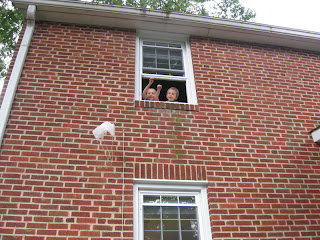Our friends Steven and Allison sent us some books of awesome science experiments even kids can do (with adult helpers to mop up the vinegar). Today we kicked things off with some acid-base chemistry. Basically, with some vinegar for the H+ and salt for the Cl-, we totally cleaned the copper oxide off some old pennies.
Dig the old pennies:
And the new pennies:

Well, maybe you can't really tell in the picture, but it was super-dramatic and also instantaneous. Awesome. Maybe this has something to do with why salt and vinegar potato chips taste so good, though further research needs to be done on this subject. Please send salt-and-vinegar potato chips.
The second experiment was much more like Actual Science, because it did not work at all. We put some baking powder in a packet of toilet paper in a glass and put some pieces of spaghetti in the packet. Supposedly, when you pour vinegar on this, the resulting carbon dioxide bubbles on the pasta shoot them up like rockets. Here's Ben adding the vinegar:
As you can see, we did not have any trouble making carbon dioxide. But the packet of baking soda kept floating up instead of staying under the pasta, even when we repeated the experiment by weighing down the packet with our beautiful clean pennies; basically, the reaction powered a toilet paper rocket instead of pasta rockets. We thought maybe our whole-wheat pasta* was too manly for the reaction to lift up, so we dug up some white stuff, but no dice-- just like science, repeating the experiment with brilliant modifications seemed sure to make a difference, but never did. Still, we made a big mess when the CO
2 foamed out onto the table, so it wasn't a total loss.
*No, silly, we're not sacrificing taste for nutrition. (Remember, we're baco-vegetarians). This tastes BETTER than white pasta. This isn't that Healthy Harvest crap they have at the grocery store. It's imported from Italy (and it's still $2.50 a pound through our dry-goods co-op) and the best part is it still comes in packages of a pound. Remember when pasta came in pound packages?
Finally, we turned to physics, sort of, by making parachutes. Practically everyone has done this at some point, so you are probably familiar with the idea. We were supposed to use corks for the parachuters, but could only find one, so we ended up with one cork ("Steven") and one cardboard cutout person ("Allison"), who flew really well, especially after we cut off everything below her neck to reduce the weight. Steven's parachute was a little more symmetrical so he had better aerodynamics and often got carried impressively far laterally by the wind, but overall, Allison fell more delightfully slowly. Here they are being released from the tree house:
And Steven getting stuck on the tree house ladder:
And finally, two more releases, one from the tree house, and one from the guest room window (which they repeated about a thousand times).
Steven kept aiming for the hydrangeas and getting buried in those weird artificial-looking blue flowers that hydrangeas sometimes have, which was a pretty good strategy on his part-- I'd rather land in flowers than on the cement patio too-- but involved lots of untangling. Overall, science is pretty much how I remember it: messy, frustrating and awesome.
























































